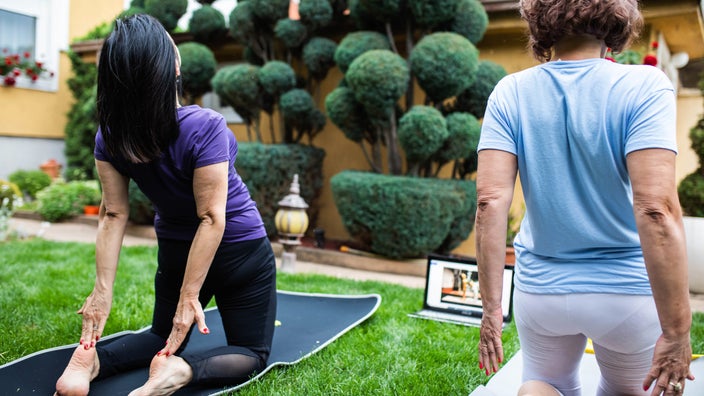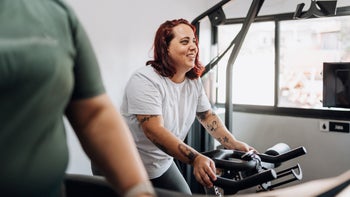
10 Exercises to Stretch and Strengthen Your Psoas Muscle
Key takeaways:
The psoas muscle is one of the hip flexor muscles that lifts the thigh. This motion is essential for walking and going up stairs.
Prolonged sitting causes the psoas muscle to become too tight. The tension can increase stress on your lower back and result in muscle imbalances. Inactivity can also weaken the psoas muscle, making it difficult to walk and lift your feet from the floor.
Stretching exercises for the psoas involve moving the hip back into extension behind the body, and strengthening exercises involve lifting the leg in front of the body.
Table of contents

Your psoas muscle is one of your hip flexors that lifts your thigh. When this muscle is too tight or weak, it can result in muscle imbalances that cause pain or hinder your ability to walk. Find out more about the role of the psoas muscle — plus, learn exercises to stretch and strengthen it.
How does the psoas muscle work?
The psoas muscle runs from the back to the front of the body, starting at the lower back and ending at the front of the leg bone (femur). It belongs to the iliopsoas muscle group, which is part of the hip flexors. The hip flexor muscles are used to lift the thigh closer to the body. Hip flexion — the lifting of the thighs — is needed for everyday movements, like walking and climbing stairs.
When the psoas muscle is too tight, it tilts the pelvis forward and increases stress on the lower back.
Search and compare options
What are the best psoas muscle stretches?
Many people spend much of the day sitting. This tightens the hip flexors, including the psoas muscle.
Because the psoas muscle flexes the hip, the opposite motion — extending the hip — stretches the psoas. Hip extension involves moving the leg back behind the body or the thighs away from the belly. Stretching may help release the psoas muscle and reduce hip and lower back pain. You’ll feel the impact of psoas stretches in the front of your hips.
1. Kneeling lunge stretch
A kneeling lunge is one of the best deep stretches for the psoas. It’s a great way to stretch the psoas muscles on your right and left sides individually, since one side of your body can be tighter.
Step 1: Begin in a half-kneeling position. The foot of your front leg should be flat on the floor. Make sure the knee and ankle of your front leg stay in line with each other, forming a 90-degree angle. The knee and shin of your back leg should be touching the floor. Make sure the knee and hip of your back leg stay in line with each other, forming a 90-degree angle.
Step 2: Shift your weight forward by pushing your hips forward. Squeeze the glute of your back leg to stretch the front of your hip further.
Step 3: Hold for 30 seconds, then relax.
Step 4: Repeat on the other side.
Step 5: Repeat 3 times on each leg, alternating between the right and left sides.
2. Camel pose
Camel pose is a yoga posture that helps open the hips. This move stretches the psoas muscle on both sides of your body at the same time.
Step 1: Start in a kneeling position with your buttocks resting on your heels.
Step 2: Place your hands on your hips. Contract your glute muscles to lift your buttocks away from your feet into a tall kneeling position. Your hips should be over your knees, with your shoulders back.
Step 3: Continue to push your hips forward as you arch your back. Reach your hands back to grab your heels or ankles. Keep squeezing your glutes and thighs to push your hips forward.
Step 4: Hold for 30 seconds, then relax.
Step 5: Repeat 3 times.
3. Glute bridge
A glute bridge moves your hips into extension, stretching the iliopsoas muscles at the front of your hips. It can help with muscle tension, lower back pain, and hip bursitis. This exercise also activates the glutes. Proper balance between the glutes and hip flexors stabilizes your hips and spine.
Step 1: Lie on your back with your knees bent and your feet flat on the floor.
Step 2: Engage your core by gently pressing your lower back toward the floor.
Step 3: Keep your back straight and lift your hips as high as you can.
Step 4: Squeeze your glutes at the top of the bridge for a deeper stretch in the front of your hips.
Step 5: Hold the bridge for 5 to 10 seconds.
Step 6: Lower your hips slowly and return to the starting position.
Step 7: Complete 15 to 20 repetitions.
Do you spend most of the day sitting? Consider these tips to reduce the health effects of too much sitting.
Hip pain while sitting: Learn common causes, plus how to treat this type of hip pain.
How to deal with an anterior pelvic tilt: Hip stretching and strengthening exercises can help correct this muscle imbalance.
4. Side-lying psoas stretch
This side-lying stretch may help release psoas muscle tension by pulling your hip back into extension. Bending your knee also helps stretch the quadriceps muscles at the front of your thighs.
Step 1: Lie on one side with your legs straight and stacked on top of each other. You can use your bottom arm to support your head.
Step 2: Bend the knee of your top leg back, bringing your heel toward your buttocks.
Step 3: Grab your ankle to pull your foot closer to your buttocks.
Step 4: While holding your foot close to your buttocks, squeeze your glute to push your hip forward. Then, pull your leg back further behind your body.
Step 5: Hold for 30 seconds, then relax.
Step 6: Repeat 3 times on each side.
5. Prone quadriceps stretch
This prone quadriceps stretch also lengthens the psoas and quad muscles. It can help with muscle tension and limited hip flexibility.
Step 1: Lie on your stomach with your legs extended, elbows bent at shoulder level, and forearms flat on the floor.
Step 2: Bend your right knee to bring your lower leg toward your body.
Step 3: Use your right hand to grasp the top of your right foot, bringing it as close to your buttock as you can.
Step 4: Hold for 15 to 30 seconds, feeling the stretch in your hip and along the front of your right thigh. Then, switch to the left side.
Step 5: Repeat 2 to 3 times on each side.
Read more like this
Explore these related articles, suggested for readers like you.
What are the best psoas muscle strengthening exercises?
Exercises that involve lifting your legs in front of you help strengthen the psoas and other hip flexor muscles.
1. Single knee-to-chest stretch
The knee-to-chest stretch can increase lower back and hip flexibility while strengthening the psoas.
Step 1: Lie on your back with your legs straight and heels touching the floor.
Step 2: Bring your knee toward your chest. You can hold the back of your thigh to move your knee as close to your chest as possible.
Step 3: Pause to hold the stretch. Then, relax your leg and return to the starting position.
Step 4: Repeat on your other leg.
Step 5: Repeat 20 times, alternating between your right and left sides.
2. Straight leg raises
Lifting your leg when it’s straight is more challenging than when it’s bent. Your hip flexors endure more pressure from lifting the weight of your leg, which requires more strength. Straight leg raises can help you build quadriceps and psoas muscle strength.
Step 1: Lie on your back with your legs straight.
Step 2: Bend one knee, placing your foot flat on the floor.
Step 3: Keep your other leg straight with the knee fully extended. Lift it slowly until the knee lines up with the knee of your bent leg.
Step 4: Hold for 5 seconds before slowly lowering your leg to the floor, while keeping it straight.
Step 5: Complete 20 repetitions with each leg.
3. Marching in place
Marching in place is a great way to raise your heart rate and build psoas muscle strength. This move is important because it helps to clear your feet from the ground when you walk or climb stairs, preventing trips and falls.
Step 1: Make sure you’re starting with good posture — keeping your back straight and your shoulders back.
Step 2: Shift your weight over to one side. Then, lift your opposite leg, bringing your thigh up to your belly as high as you can. Swing your opposite arm as you raise your leg.
Step 3: Hold for 2 seconds. Then, relax your leg and return to the starting position.
Step 4: Repeat with your other leg, then relax.
Step 5: Repeat 30 times, alternating between right and left sides.
4. Frankensteins
Frankensteins are a dynamic move that can increase your range of motion and strengthen the psoas, quadriceps, and hamstrings.
Step 1: Stand with your arms extended straight out in front of you at shoulder level.
Step 2: Shift your weight over to one side. Lift your opposite leg, keeping it straight, with your knee fully extended. Lift your leg as high as you can with control. If you can, depending on your flexibility, touch your hands to your toes.
Step 3: Hold for 2 seconds. Then, relax your leg and return to the starting position.
Step 4: Repeat with your other leg, then relax.
Step 5: Repeat 30 times, switching between the right and left sides.
5. Mountain climbers
A mountain climber is a total-body exercise that works core, hip, and leg muscles.
Step 1: Start in a plank position with your hands a little wider than shoulder width apart, palms flat, and toes touching the floor.
Step 2: Draw your belly button toward your spine to engage your core. Keep your back flat.
Step 3: Bring your right knee toward your chest as far as you can.
Step 4: Switch sides, bringing your right leg to the starting position and your left knee toward your chest.
Step 5: Keep your back flat and your hips down as you continue to alternate legs as quickly as you can for 30 seconds.
What causes pain and tightness in your psoas muscle?
Prolonged sitting and other sedentary behavior can tighten the psoas muscle. Because the psoas muscle attaches to the spine, psoas muscle tightness increases lower back tension. Inactivity can also weaken the psoas muscle. That weakness limits your ability to lift your leg, which can interfere with walking and climbing stairs.
Psoas muscle tightness also affects the alignment of the hip joint, preventing it from extending fully. This makes it difficult to activate the glute muscles. Without proper activation, the glutes can’t stabilize the legs. This leads to poor balance, difficulty walking, and muscle imbalances.
Stretching and strengthening exercises that target the psoas can correct muscle imbalances, improve hip and lower back alignment, and decrease pain.
Are there other ways to prevent or release psoas muscle tension?
In addition to stretching and strengthening exercises, you can try these tips to prevent or release psoas muscle tension:
Try foam rolling. Foam rolling is a form of self-massage — or myofascial release — that targets the connective tissue (fascia) around your bones, muscles, and joints. It can help you recover after exercise and may prevent muscle pain and stiffness. Try foam rolling exercises for the hips, glutes, and lower back to help release tight psoas muscles.
Take breaks throughout the day. If your job or other daily activities involve sitting for long periods, take breaks every 30 minutes. You can stand up, stretch, or walk to keep your muscles loose and minimize the effects of prolonged sitting.
Create a balanced fitness plan. Your weekly exercise routine should include a mix of cardio and strength-training exercises for your whole body. You can cross-train with flexibility workouts, such as Pilates or yoga.
Warm up before and cool down after every workout. A brief warm-up and cooldown before and after each workout can increase your flexibility and range of motion. This may reduce the risk of injuries. Try dynamic stretches to warm up. And switch to light cardio and static stretches to cool down.
Make time for rest and recovery. Rest and recovery are essential for any fitness plan. This time helps your muscles adjust to your workouts. It can also restore your energy and prevent injuries or overtraining. You can use weekly rest days to do lower-intensity active recovery workouts, such as swimming or tai chi.
Talk to a healthcare professional if psoas muscle pain or tension continues or worsens with home treatment. They may recommend physical therapy.
The bottom line
The psoas muscle is an important hip flexor that helps lift the thighs, allowing you to walk and climb stairs. Prolonged sitting and other sedentary behavior can make the psoas tight or weak. Exercises that target the psoas muscle can improve strength and flexibility and decrease muscle imbalances.
Why trust our experts?



References
24Life. (2018). Prone quad stretch | Legs for days | 24Life [video]. YouTube.
Alo Moves - Online Yoga and Fitness Videos. (2019). How to do camel pose | Ustrasana tutorial with Dylan Werner [video]. YouTube.
Anderson, C. N. (2016). Iliopsoas: Pathology, diagnosis, and treatment. Clinics in Sports Medicine.
Baptist Health. (2020). Straight leg raises [video]. YouTube.
Dydyk, A. M., et al. (2023). Psoas syndrome. StatPearls.
Exercise Library - Joanna Soh. (2017). How to do march on the spot | Joanna Soh [video]. YouTube.
Glenister, R., et al. (2023). Anatomy, bony pelvis, and lower limb, hip. StatPearls.
HowCast. (2012). How to do a mountain climber | Boot camp workout [video]. YouTube.
Kim, B., et al. (2020). Core stability and hip exercises improve physical function and activity in patients with non-specific low back pain: A randomized controlled trial. The Tohoku Journal of Experimental Medicine.
Konrad, A., et al. (2021). The influence of stretching the hip flexor muscles on performance parameters. A systematic review with meta-analysis. International Journal of Environmental Research and Public Health.
Matthews, C. E., et al. (2021). Sedentary behavior in United States adults: Fall 2019. Medicine and Science in Sports and Exercise.
Mohanty, P. P., et al. (2017). Effect of stretching of piriformis and iliopsoas in coccydynia. Journal of Bodywork and Movement Therapies.
My Rehab Connection. (2016). Kneeling lunge stretch [video]. YouTube.
Nuffield Health. (2015). How to side hip and quad stretch. | Nuffield Health [video]. YouTube.
Schroeder, A. N., et al. (2015). Is self myofascial release an effective preexercise and recovery strategy? A literature review. Current Sports Medicine Reports.
Silappathikaram, T. (2024). Psoas major and minor muscles and iliacus muscle. StatPearls.
Twin Cities Orthopedics. (2013). Dynamic warmup exercises | How to do Frankenstein warmup [video]. YouTube.



























